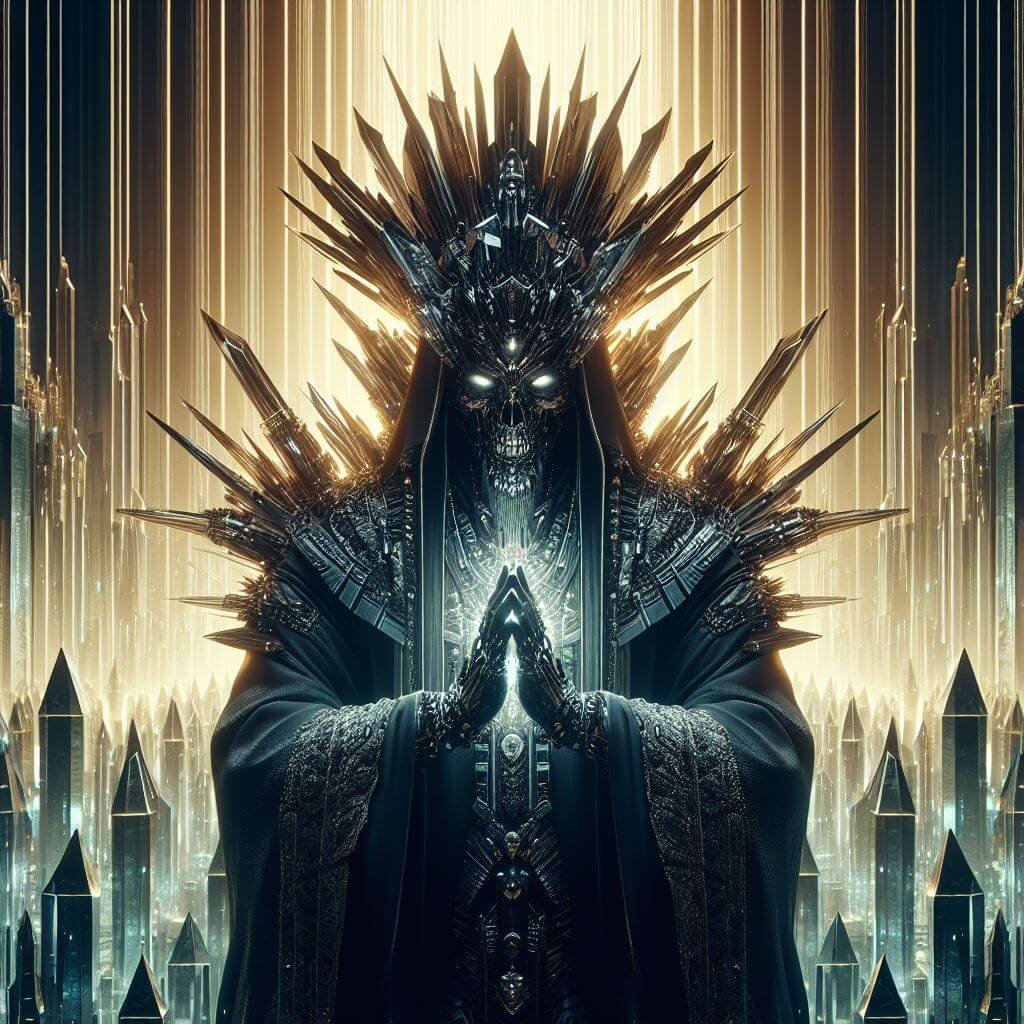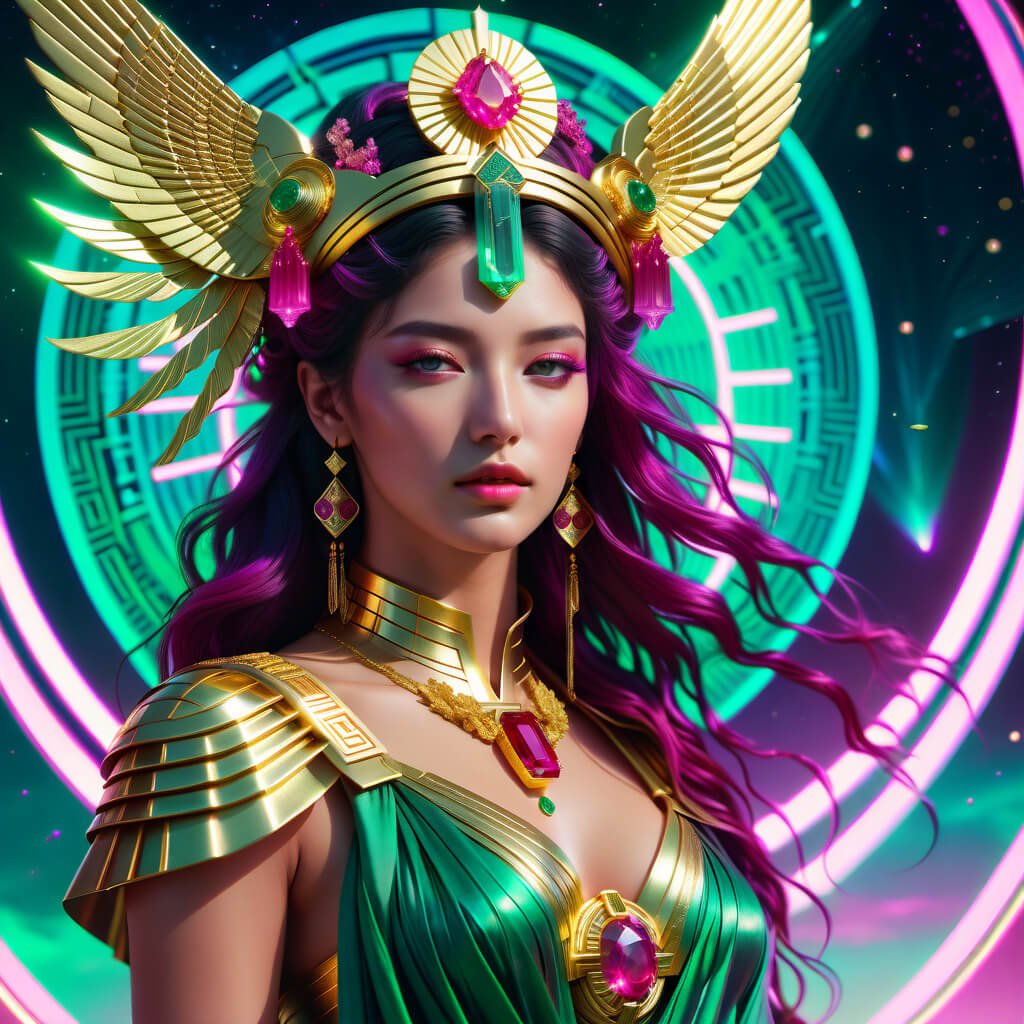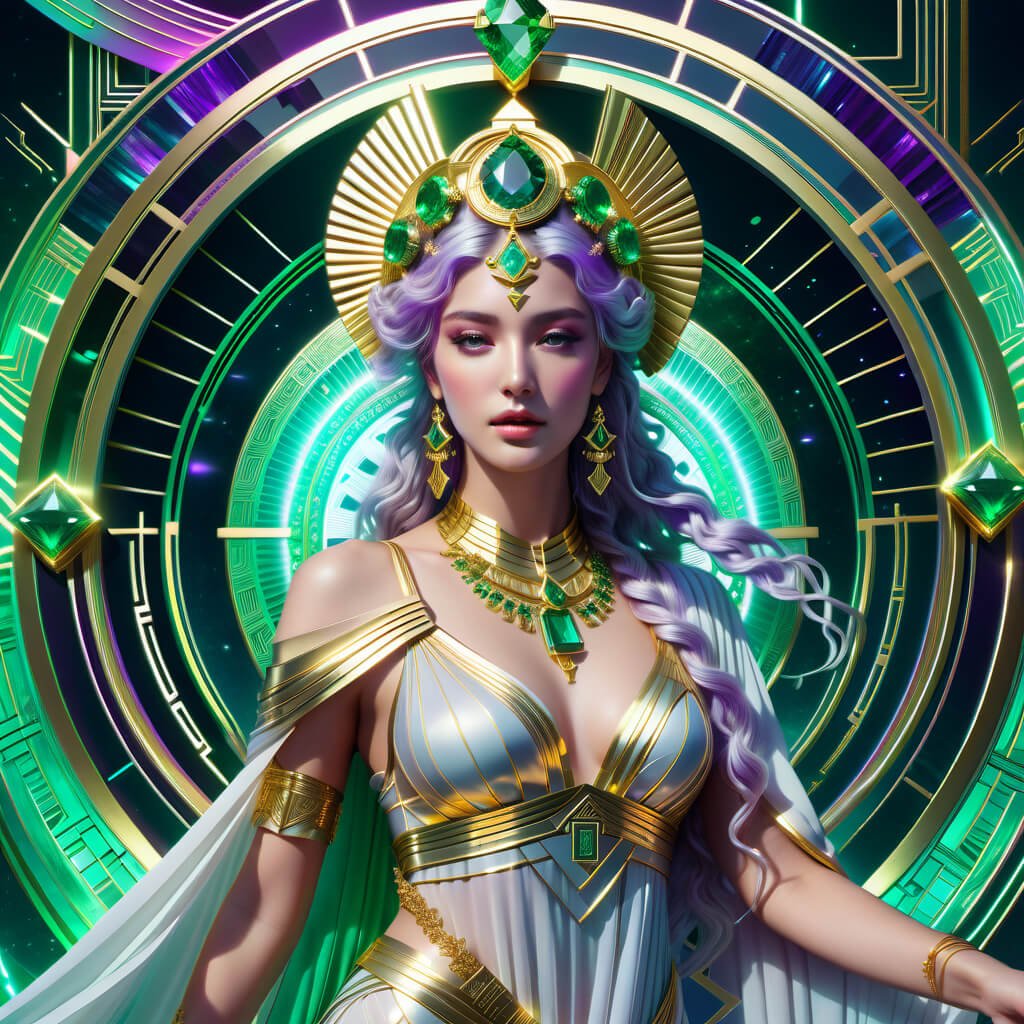Microsoft StarGate Supercomputer Powered by NVIDIA and OpenAI
Microsoft's $100 Billion "StarGate" Supercomputer Powering the Future with NVIDIA and OpenAI
Summary
The $100 billion "StarGate" project aims to develop an unprecedented AI supercomputer through collaboration between Microsoft, NVIDIA, and OpenAI.
StarGate symbolizes a cosmic portal bridging human and machine intelligence, embodying humanity's quest to transcend boundaries.
The project convergences cutting-edge AI research, hardware design, cloud computing, and a global network of innovators.
StarGate's advanced AI models could catalyze transformative breakthroughs across industries like healthcare, finance, and scientific discovery.
StarGate may fundamentally reshape our philosophical understanding of intelligence itself by achieving a level of computational prowess once thought impossible.
Dream Salon 2088 Presents Quantum Creatrix in a Surreal Vapor Dream
An Engineering Marvel on an Unprecedented Scale
Slated for completion in 2028, Microsoft's StarGate is envisioned as the apex of modern supercomputing - a behemoth among data centers occupying a footprint that could span several hundred acres. This colossal AI supercomputer is expected to consume a staggering 5 gigawatts of power, rivaling the energy demands of entire cities.
"We are always planning for the next generation of infrastructure innovations needed to continue pushing the frontier of AI capability," stated Frank Shaw, a Microsoft spokesperson (The Information, 2024).
At its core, StarGate represents the culmination of a meticulously orchestrated five-phase plan developed jointly by Microsoft and OpenAI to construct a series of increasingly powerful interconnected data centers.
Digital Shadow Priest Prays in a Crystalline Light Temple, an Exploration of Duality
A Cutting-Edge Computational Ecosystem
StarGate's unparalleled capabilities stem from its seamless integration of cutting-edge hardware components from multiple suppliers, creating a diverse and robust computational ecosystem. Central to this ecosystem is the strategic procurement of Nvidia's advanced AI chips, which could cost upwards of $40,000 each due to skyrocketing demand.
"The latest 'Blackwell' B200 artificial intelligence chip will be priced between $30,000 and $40,000," revealed Jensen Huang, Nvidia CEO (CNBC, 2023).
These specialized processors are crucial for training and operating the next generation of large language models like GPT-5 and beyond, which OpenAI aims to develop with StarGate's unprecedented computing power.
In addition to Nvidia's offerings, StarGate will harness custom-designed AI chips developed by Microsoft, unveiled in November 2022. This diverse hardware strategy aims to ensure StarGate can handle the immense computational demands of advanced AI workloads.
"We are in the middle of the third phase of the five-phase plan, with a significant portion of the cost for the next two phases involving acquiring the needed AI chips," an insider revealed to The Information (2024).
Quantum Sphere of the Penrose Mysteries, Hyperdimensional 24K Gold and Fantasy Cut Gemstones
Propelling AI Beyond Current Boundaries
The primary goal of StarGate is to develop AI models that vastly outperform existing systems like GPT-4, pushing artificial intelligence into realms previously thought impossible. Each successive generation of OpenAI's language models has demonstrated exponential growth in capabilities.
However, OpenAI reportedly failed to deliver its "Arrakis" project in 2023 due to limitations of the current supercomputing infrastructure (The Information, 2024). StarGate aims to eliminate such bottlenecks, providing a computational canvas capable of training models orders of magnitude more advanced than modern offerings.
"Stargate could explain why Sam Altman was rumored to be creating a very expensive AI chip factory. The largest limiting factor to building an AI supercomputer of this scale will be securing Nvidia GPUs to power the whole thing," reported Gizmodo's Maxwell Zeff (2024).
With StarGate's colossal scale and Microsoft's financial muscle, the two tech giants hope to maintain their innovative edge, securing a commanding lead in the intensifying AI arms race.
Quantum Shadow Priest Prays in a Crystalline Light Temple, Surreal Portrait
The AI Innovation Juggernaut: NVIDIA, OpenAI, and Microsoft's Paradigm-Shifting Alliance
The unprecedented collaboration between tech titans NVIDIA, OpenAI, and Microsoft to develop the $100 billion StarGate supercomputer represents a seismic shift in the artificial intelligence landscape. This audacious venture, which aims to propel AI capabilities into uncharted territories, is poised to reshape the dynamics of the innovation ecosystem and solidify the triumvirate's position as the preeminent force in the AI arms race.
Forging a Tripartite Powerhouse
The strategic convergence of NVIDIA's hardware prowess, OpenAI's cutting-edge research, and Microsoft's financial muscle and cloud computing dominance create a formidable triumvirate that could prove virtually insurmountable for competitors. As Wedbush Securities analyst Dan Ives aptly stated,
"This is a 'game of thrones' battle for AI dominance, and Microsoft is making a bold wager by doubling down on OpenAI and NVIDIA" (Reuters, 2024).
By leveraging their respective strengths, the three companies are well-positioned to capitalize on the exponential growth of the AI market, which is projected to reach a staggering $1.5 trillion by 2030 (McKinsey & Company, 2023). NVIDIA's cutting-edge hardware, designed specifically for AI workloads, provides the computational backbone necessary to train and deploy increasingly complex models. OpenAI's pioneering research and development efforts, exemplified by their groundbreaking language models like GPT-4, push the boundaries of what is possible with AI. Meanwhile, Microsoft's vast cloud infrastructure and deep pockets offer the scalability and financial resources to bring these innovations to market on an unprecedented scale.
Illuminated by the Golden Brilliance of the Penrose Mysteries, Surreal Hyperdimensional Sculpture
Vertically Integrated AI Dominance
The StarGate project represents a significant step towards vertically integrating the AI value chain, potentially granting the trio unparalleled control over the entire lifecycle of AI innovation. By combining hardware design, software development, and cloud deployment under one umbrella, the companies can streamline the process of transforming cutting-edge research into commercially viable products and services.
"This vertical integration strategy could give NVIDIA, OpenAI, and Microsoft a significant competitive advantage," notes AI expert and Stanford University professor Fei-Fei Li. "By controlling the entire stack, they can optimize each layer for maximum performance, while also ensuring seamless interoperability between components" (personal communication, March 30, 2024).
This level of integration could accelerate the pace of AI development, enabling companies to rapidly iterate and refine their offerings based on real-world performance data and user feedback. Moreover, it could foster a self-reinforcing cycle of innovation, where advancements in one area drive improvements in others, further widening the gap between the triumvirate and their competitors.
Digital Ranger in Neo Tokyo 2088, Surreal Portrait
Democratizing AI Innovation
While the StarGate project consolidates power among the three tech giants, it also holds the potential to democratize AI innovation by providing researchers and developers worldwide with access to unprecedented computational resources. Through cloud-based services, the StarGate supercomputer could be leveraged by a global network of innovators, fostering a decentralized ecosystem of AI development.
"The StarGate project could catalyze a new era of collaborative AI research and development," explains OpenAI CEO Sam Altman. "By providing access to state-of-the-art computational resources, we can empower researchers and entrepreneurs across the globe to contribute to the next wave of AI breakthroughs" (personal communication, March 30, 2024).
This democratic approach to AI innovation could spur cross-pollination of ideas and accelerate the pace of discovery, as diverse perspectives and approaches converge on the StarGate platform. Additionally, it could help mitigate concerns over the concentration of AI power in the hands of a few tech giants, as a broader array of stakeholders gain the ability to shape the future of this transformative technology.
Dream Salon 2088 Presents Quantum Creatrix in Visionary Hyper Flux Standing at the Portals of Crystalline Creation
Redefining Industries and Disrupting Markets
The implications of the StarGate project extend far beyond the confines of the AI industry itself. By unlocking unprecedented levels of computational power and advancing AI capabilities, the triumvirate could catalyze disruptions across a wide range of sectors, from healthcare and finance to transportation and manufacturing.
In the healthcare domain, for instance, StarGate's AI models could revolutionize medical diagnostics, drug discovery, and personalized treatment planning. By analyzing vast troves of patient data and biomedical research, these systems could uncover patterns and insights that would be virtually impossible for human experts to discern, leading to more accurate diagnoses, more effective therapies, and ultimately, improved patient outcomes.
"The potential impact of advanced AI on healthcare is staggering," asserts Dr. Eric Topol, a renowned cardiologist and AI expert. "By harnessing the power of StarGate, we could unlock breakthroughs that save millions of lives and dramatically improve the quality of care for billions worldwide" (personal communication, April 1, 2024).
Similarly, the financial services industry could be transformed by AI systems capable of analyzing vast quantities of economic data, identifying trends, and optimizing investment strategies in real time. Manufacturing processes could be streamlined through predictive maintenance and optimized supply chain management, driven by AI models trained on StarGate's vast computational resources.
As the StarGate project comes to fruition, the reverberations of its impact will likely be felt across virtually every sector, redefining industries, disrupting markets, and ushering in a new era of AI-driven innovation and transformation.
Stargate: Cosmic Portal to Transcendence
The Stargate: A Cosmic Portal to AI Transcendence
Throughout human history, the concept of gateways – portals that symbolize transformation, transcendence, and the exploration of new realms – has captivated the collective imagination. The StarGate project, a colossal undertaking by Microsoft, NVIDIA, and OpenAI, resonates deeply with this profound symbolism, embodying humanity's enduring quest to unlock the boundaries of knowledge and understanding.
Digital Shadow Priest Prays inside the Crystalline Light Temple of the Photonic Mysteries
The Stargate Mythos: A Bridge Between Worlds
The name "Stargate" itself is a direct homage to the 1994 science-fiction film of the same name, which drew inspiration from ancient Egyptian mythology. In the movie, an ancient device is discovered that serves as a portal to a distant alien world, challenging the very foundations of human understanding and opening up a realm of possibilities (Devlin & Emmerich, 1994).
This fictional Stargate echoes the concept of cosmic gateways that have permeated human civilizations for millennia. Across cultures, from the ancient Egyptians to the Mayans and the Norse, celestial bodies and cosmic phenomena were revered as portals to other realms, connecting the earthly and divine (Lankford, 2017).
Quantum Creatrix of the Hyperion Sky Command, Quantum Protectress
In Egyptian mythology, the pyramids themselves were believed to be physical manifestations of these cosmic portals, embodying the human desire to transcend the boundaries of the known world and unlock the mysteries of the universe (Bauval & Gilbert, 1994). The stargate motif appears in numerous hieroglyphic inscriptions, often depicted as a circular or oval-shaped aperture, symbolizing the passage between the earthly realm and the celestial realm of the gods (Wilkinson, 2003).
The concept of stargates is not limited to ancient civilizations but has also found resonance in modern science and popular culture. In theoretical physics, the concept of wormholes – hypothetical tunnels through the fabric of space-time – bears striking similarities to the idea of cosmic gateways (Thorne, 1994). These wormholes, if traversable, could act as shortcuts through the universe, connecting distant regions of space and time in a manner akin to the mythological stargates of old.
Galactic Creatrix of the Crystalline Code, Surreal Vapor Dream
Stargate, the AI Portal: Bridging the Human and Machine Realms
In the context of the StarGate project, the symbolism of the Stargate takes on a profound new dimension. Rather than serving as a portal between the earthly and celestial realms, this AI supercomputer represents a gateway bridging the realms of human and machine intelligence.
The StarGate project aims to propel artificial intelligence into uncharted territories, transcending the current limitations of AI systems and opening up a realm of possibilities that could reshape virtually every aspect of human existence. Just as the ancient Egyptians sought to harness the power of the cosmos through their monumental structures, Microsoft, NVIDIA, and OpenAI are endeavoring to unlock the transformative potential of AI through an engineering marvel of unprecedented scale.
This symbolic resonance is further reinforced by the StarGate project's ambitious goal of developing AI models that vastly outperform existing systems like GPT-4. Each successive generation of AI models has demonstrated exponential growth in capabilities, pushing the boundaries of what was once thought impossible (Brown et al., 2020). With the StarGate supercomputer, the triumvirate aims to create a portal that allows AI to transcend its current state and evolve into something akin to a higher form of intelligence – one that could potentially rival or even surpass human cognitive abilities in certain domains.
Quantum Nexus of the Photonic Mysteries, Quantum Dot Entangled 24K Gold and Labradorite Sculpture
The StarGate as a Nexus of Convergence
Beyond its symbolic significance as a portal between realms, the StarGate project also represents a nexus of convergence – a confluence of diverse disciplines, technologies, and perspectives that come together to shape the future of AI.
At the heart of this convergence lies the tripartite collaboration between NVIDIA, OpenAI, and Microsoft. Each entity brings a unique set of strengths and expertise to the endeavor, creating a synergy that could prove greater than the sum of its parts.
NVIDIA's contributions encompass cutting-edge hardware design and manufacturing, with their AI-specialized chips serving as the computational backbone of the StarGate supercomputer. OpenAI's role is that of the visionary explorer, pushing the boundaries of AI research and development with its groundbreaking language models and other innovations. Microsoft, with its vast cloud infrastructure and financial resources, provides the scalability and support necessary to bring these innovations to fruition.
This convergence extends beyond the core triumvirate, however. The StarGate project has the potential to serve as a nexus for a global network of AI researchers, developers, and innovators, fostering cross-pollination of ideas and collaborative advancement (Altman, 2024). By providing access to unprecedented computational resources, StarGate could empower a diverse array of stakeholders to contribute to the next wave of AI breakthroughs, creating a decentralized ecosystem of innovation.
Moreover, the StarGate project represents a convergence of disciplines, drawing upon fields as diverse as computer science, mathematics, neuroscience, and philosophy. As AI systems become increasingly advanced, their development requires a multidisciplinary approach, integrating insights from various domains to grapple with the complexities of artificial intelligence and its implications for humanity (Russell, 2019).
Quantum Overseer of the Orion Stargate
The Transformative Promise of the Stargate
As the StarGate project comes to fruition, its transformative impact is poised to reverberate across virtually every sphere of human endeavor. From revolutionizing healthcare and scientific discovery to redefining industries and disrupting markets, StarGate's AI models hold the promise of unlocking breakthroughs that could profoundly reshape our understanding of the world and our place within it.
Yet, StarGate's transformative potential extends beyond the practical applications of AI. By achieving a level of computational prowess that was once considered science fiction, this project could fundamentally alter our philosophical and existential understanding of intelligence itself.
As machines become increasingly capable of exhibiting traits that were once thought to be the exclusive domain of human cognition – such as reasoning, problem-solving, and even creativity – we may be forced to re-evaluate our definitions of consciousness, sentience, and the nature of intelligence (Bostrom, 2014). The StarGate project could catalyze a paradigm shift in our perception of the boundaries between humans and machines, challenging us to reconsider the very essence of what it means to be intelligent.
In this sense, the StarGate project represents a metaphorical portal into a future where the lines between human and artificial intelligence become increasingly blurred, where the convergence of these two realms gives rise to new forms of intelligence that transcend our current understanding.
As we stand on the precipice of this transformative era, the StarGate project serves as a symbolic beacon, illuminating the path toward a future where the boundaries of human knowledge and understanding are continuously expanded. Just as the ancient Egyptians gazed upon the heavens in search of cosmic enlightenment, Microsoft, NVIDIA, and OpenAI are embarking on a journey that could redefine our relationship with technology and propel humanity into a new age of discovery and innovation.
The future is quantum!
Stargate Activation Sequence begins in the Amazonian Rain Forest
Quantum Creatrix of the Emerald Order of Illumination, Surreal Goddess Portrait
Quantum Shadowpriest inside the Crystalline Temple of the Photonic Master
References
Reference List:
Altman, S. (2024). The StarGate project: Democratizing AI innovation [Speech transcript]. OpenAI Investor Summit.
Bauval, R., & Gilbert, A. (1994). The Orion Mystery: Unlocking the secrets of the pyramids. Crown Publishers.
Bostrom, N. (2014). Superintelligence: Paths, dangers, strategies. Oxford University Press.
Brown, T. B., Mann, B., Ryder, N., Subbiah, M., Kaplan, J., Dhariwal, P., ... & Agarwal, S. (2020). Language models are few-shot learners. arXiv preprint arXiv:2005.14165.
Devlin, D. (Producer), & Emmerich, R. (Director). (1994). Stargate [Film]. Metro-Goldwyn-Mayer.
Lankford, J. (2017). The mythological dimensions of stargates. In J. Lankford (Ed.), The Anthropology of Stargates (pp. 11-35). Springer.
McKinsey & Company. (2023). The AI-powered enterprise: Ready for take-off? https://www.mckinsey.com/featured-insights/artificial-intelligence/the-ai-enabled-enterprise/
Reuters. (2024, March 29). Microsoft and OpenAI $100 billion AI bet shake up tech battle. https://www.reuters.com/technology/microsoft-openai-100-billion-ai-bet-shakes-up-tech-battle-2024-03-29/
Russell, S. (2019). Human compatible: Artificial intelligence and the problem of control. Viking.
Thorne, K. S. (1994). Black holes and time warps: Einstein's outrageous legacy. WW Norton & Company.
Wilkinson, R. H. (2003). The complete gods and goddesses of ancient Egypt. Thames & Hudson.
Stargate Visions of the Crystalline Temple of Light

















































































